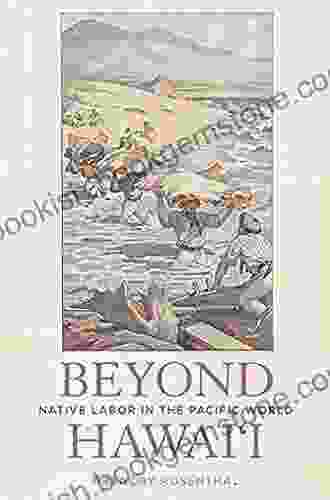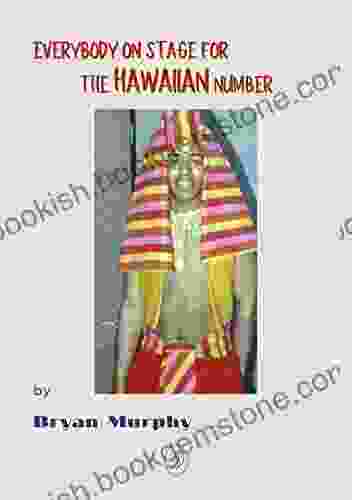Everybody On Stage for the Hawaiian Number: A Journey into Polynesian Performance Art

Polynesian performance art is a vibrant and captivating expression of culture and tradition, captivating audiences with its infectious rhythms, graceful movements, and colorful costumes. From the rhythmic beats of the ukulele to the graceful movements of the hula, Polynesian performance art is a testament to the rich cultural heritage of the Pacific Islands. This article takes a deep dive into the fascinating world of Polynesian performance art, exploring its history, styles, and cultural significance.
5 out of 5
| Language | : | English |
| Text-to-Speech | : | Enabled |
| Enhanced typesetting | : | Enabled |
| Word Wise | : | Enabled |
| Lending | : | Enabled |
| File size | : | 9907 KB |
| Screen Reader | : | Supported |
| Print length | : | 198 pages |
A Tapestry of Cultural Heritage
Polynesian performance art has its roots in the ancient traditions of the indigenous peoples of the Pacific Islands, who used dance, music, and storytelling to pass down their cultural heritage from generation to generation. These performances were an integral part of religious ceremonies, celebrations, and social gatherings, serving to strengthen communal bonds and preserve cultural identity.
Over the centuries, Polynesian performance art has evolved and diversified, influenced by contact with other cultures and the unique experiences of each island group. Today, Polynesian performance art encompasses a wide range of styles, each with its own distinct characteristics.
Vibrant Styles and Cultural Symbolism
- Hula (Hawaii): Hula is the most well-known Polynesian dance style, characterized by its graceful hand movements, rhythmic footwork, and vibrant costumes. Hula is both a sacred and secular art form, with different styles used for different occasions.
- Haka (Maori): Haka is a powerful and energetic dance performed by Maori warriors. It involves rhythmic chanting, stamping feet, and fierce facial expressions, and is used to express strength, pride, and cultural identity.
- Ote'a (Tahiti): Ote'a is a lively and sensual dance performed by Tahitian women. It features hip-swaying movements, rapid hand gestures, and elaborate costumes, and is often accompanied by the rhythmic beat of drums.
- Samoan Fire Knife Dance: This thrilling dance involves spinning flaming knives in a mesmerizing display of skill and coordination. It is a traditional Samoan dance that is often performed at cultural festivals and celebrations.
Each Polynesian performance style is rich in cultural symbolism, with every movement, gesture, and costume element carrying a specific meaning. For example, in hula, hand gestures can represent different aspects of nature, such as the ocean, the wind, and the stars. In haka, facial expressions are used to convey emotions such as anger, pride, and determination.
Traditional Instruments and Costumes
Polynesian performance art is not only about dance and movement but also about the music and costumes that accompany it. Traditional instruments vary from island group to island group, but commonly include:
- Ukulele: A small guitar-like instrument with a distinctive sound, the ukulele is a staple of Hawaiian music.
- Drums: Drums are used to provide a rhythmic base for many Polynesian dances, from the thunderous beats of the Tahitian to'ere to the delicate rhythms of the Samoan pate.
- Chants: Chants are an important part of many Polynesian performances, used to tell stories, express emotions, and invoke the gods.
Costumes are also an essential element of Polynesian performance art, with vibrant colors, intricate designs, and elaborate headdresses that reflect the cultural and spiritual significance of the dance. In hula, for example, dancers often wear skirts made of ti leaves or tapa cloth, while in haka, Maori warriors wear traditional flax skirts and body paint.
Cultural Significance and Preservation
Polynesian performance art is more than just entertainment; it is a vital part of the cultural identity of the Pacific Islands. It serves to preserve cultural heritage, strengthen communal bonds, and pass down traditions from generation to generation. In recent years, there has been a growing movement to revitalize and preserve Polynesian performance art, with cultural groups and organizations working to teach traditional dances, music, and crafts to younger generations.
The preservation of Polynesian performance art is essential for the survival of Pacific Island cultures. By keeping these traditions alive, we not only honor the past but also ensure that future generations can experience the beauty and richness of Polynesian heritage.
Polynesian performance art is a mesmerizing and diverse art form that captivates audiences with its vibrant rhythms, graceful movements, and colorful costumes. From the sacred hula of Hawaii to the powerful haka of the Maori, Polynesian performance art is a testament to the rich cultural heritage of the Pacific Islands. It is an art form that continues to evolve and inspire, serving as a bridge between the past and the present, and a reminder of the enduring power of culture and tradition.
So next time you have the opportunity to witness a Polynesian performance, take it. Immerse yourself in the beauty and diversity of this captivating art form, and let the rhythms and movements transport you to the vibrant shores of the Pacific Islands.
5 out of 5
| Language | : | English |
| Text-to-Speech | : | Enabled |
| Enhanced typesetting | : | Enabled |
| Word Wise | : | Enabled |
| Lending | : | Enabled |
| File size | : | 9907 KB |
| Screen Reader | : | Supported |
| Print length | : | 198 pages |
Do you want to contribute by writing guest posts on this blog?
Please contact us and send us a resume of previous articles that you have written.
 Best Book
Best Book Page Flip
Page Flip Bookshelf
Bookshelf Literary loom
Literary loom Chapter
Chapter Bookish
Bookish PageTurner
PageTurner Bibliophile
Bibliophile Story
Story Inkwell
Inkwell Bookworm
Bookworm Labyrinth
Labyrinth Plot Twist
Plot Twist Prose
Prose Paperback
Paperback Storyteller
Storyteller Sanctuary
Sanctuary Fiction
Fiction Reading
Reading Chronicle
Chronicle Read
Read Neal Adams
Neal Adams Tanya Talaga
Tanya Talaga Anne H Berry
Anne H Berry Megan Wells
Megan Wells Richard S Dunn
Richard S Dunn David Kadavy
David Kadavy Akire C
Akire C Platte Productions Llc
Platte Productions Llc William Carroll
William Carroll Pamela Cutter
Pamela Cutter Peter L Phillips
Peter L Phillips Ben Box
Ben Box Tiya Rayne
Tiya Rayne Wesley Gardner
Wesley Gardner Mary Carolyn Waldrep
Mary Carolyn Waldrep Jim Santos
Jim Santos Kelcey Coe
Kelcey Coe W Glenn Griffin
W Glenn Griffin Kennedy Ryan
Kennedy Ryan Sally Blake
Sally Blake Lara Quaranta
Lara Quaranta Victoria Charles
Victoria Charles Richard Paul Russo
Richard Paul Russo Kyriacos C Markides
Kyriacos C Markides Margaret C Collier
Margaret C Collier Veronica G Henry
Veronica G Henry Mike Lowery
Mike Lowery Naveed Rouhani
Naveed Rouhani Christopher Reutinger
Christopher Reutinger James Hall
James Hall Regine Abel
Regine Abel Kathy Valentine
Kathy Valentine Joan Breton Connelly
Joan Breton Connelly John Thompson
John Thompson Marcy Conway
Marcy Conway Carl E Schorske
Carl E Schorske Yelapa Memo
Yelapa Memo Lesley Riley
Lesley Riley Mary Beard
Mary Beard Vicki Rozema
Vicki Rozema Derek Baxter
Derek Baxter Richard Matheson
Richard Matheson Nisha Garg
Nisha Garg Laura Reiter
Laura Reiter Matthew Hahn
Matthew Hahn Sharon Stone
Sharon Stone Rachel Shirley
Rachel Shirley Luis Angel Echeverria
Luis Angel Echeverria Randi Minetor
Randi Minetor Michael Oher
Michael Oher Roger Zelazny
Roger Zelazny Michael A Hoey
Michael A Hoey Marc Cameron
Marc Cameron Elliot Beier
Elliot Beier Krystyna Chiger
Krystyna Chiger Caroline Eden
Caroline Eden Tim Anderson
Tim Anderson Sangeeta Prasad
Sangeeta Prasad Laylah Roberts
Laylah Roberts Julian Rothenstein
Julian Rothenstein Ruth Reichl
Ruth Reichl Alicia Beckton
Alicia Beckton Myrnoska Scott
Myrnoska Scott Tim Moss
Tim Moss Marianna Leivaditaki
Marianna Leivaditaki Miranda Bridges
Miranda Bridges Joseph Toone
Joseph Toone Duncan James
Duncan James Regina Clarke
Regina Clarke Richard J Powell
Richard J Powell Steve Alpert
Steve Alpert Nic Oatridge
Nic Oatridge Bwwm Club
Bwwm Club 1st Ed 2020 Edition Kindle Edition
1st Ed 2020 Edition Kindle Edition Sosha Davis
Sosha Davis Bill Rumpel
Bill Rumpel Alyssa Campbell
Alyssa Campbell Michelle Jackson
Michelle Jackson Scott Brown
Scott Brown W David Baird
W David Baird Usman Zafar Paracha
Usman Zafar Paracha Lewis Smile
Lewis Smile Ping Fu
Ping Fu Jesse Thistle
Jesse Thistle Keiko Okamoto
Keiko Okamoto Nicholas Sparks
Nicholas Sparks Katy Sprinkel
Katy Sprinkel Robin Hobb
Robin Hobb Patrick Herrendorf
Patrick Herrendorf Patrice Gopo
Patrice Gopo Karma Waltonen
Karma Waltonen David S Luton
David S Luton Tim Gallagher
Tim Gallagher Mary Breu
Mary Breu Margaret Eggleton
Margaret Eggleton Don Peri
Don Peri Nia Arthurs
Nia Arthurs Lisa Maker
Lisa Maker Karl Ove Knausgaard
Karl Ove Knausgaard Timothy S Susanin
Timothy S Susanin Renia Spiegel
Renia Spiegel Vincent Van Gogh
Vincent Van Gogh Stephen Coles
Stephen Coles Lisa Brahin
Lisa Brahin Graham Cole
Graham Cole Jeff W Bens
Jeff W Bens Janice Tingum
Janice Tingum John Paul Stonard
John Paul Stonard Jessica Garrison
Jessica Garrison Jubilee Brown
Jubilee Brown Mariam Elias
Mariam Elias Tom Sito
Tom Sito Ryan Roenfeld
Ryan Roenfeld Robbie Quinn
Robbie Quinn Tom Sterling
Tom Sterling Brian Kevin
Brian Kevin Nolan Clark
Nolan Clark Will Jawando
Will Jawando Shemer Kuznits
Shemer Kuznits Clara Nieto
Clara Nieto Richard Delacy
Richard Delacy Joe R Lansdale
Joe R Lansdale Mark Odegard
Mark Odegard Mary Stuart
Mary Stuart Kristin Harmel
Kristin Harmel Klas Kristiansson
Klas Kristiansson Priscilla Batzell
Priscilla Batzell Shelly Kim
Shelly Kim Malcolm C Salaman
Malcolm C Salaman Megan Marshall
Megan Marshall Tom Brosnahan
Tom Brosnahan Lisa Smith
Lisa Smith Meredith Dillman
Meredith Dillman Kenneth Ma
Kenneth Ma M A Rothman
M A Rothman Shaopeng Chen
Shaopeng Chen Russell Zimmerman
Russell Zimmerman Norman M Shulman
Norman M Shulman Robert Rummel Hudson
Robert Rummel Hudson Odie Hawkins
Odie Hawkins William Gibson
William Gibson Lisa See
Lisa See Liz Chaderton
Liz Chaderton Wallace Terry
Wallace Terry Neil Fontaine
Neil Fontaine Ed Gillis
Ed Gillis Ulrike Fuchs
Ulrike Fuchs 1st Ed 2016 Edition
1st Ed 2016 Edition David J Schmidt
David J Schmidt Calum Best
Calum Best Robert Henri
Robert Henri Tova Rabinowitz
Tova Rabinowitz Michael R Jackson
Michael R Jackson Mimi Thorisson
Mimi Thorisson Julia Walker
Julia Walker Lauren Scruggs
Lauren Scruggs Brenda Lyons
Brenda Lyons Lou Darvas
Lou Darvas Tom Fay
Tom Fay Requiem Scolopendra
Requiem Scolopendra John Fabian Carlson
John Fabian Carlson Vivian Gibson
Vivian Gibson Marcos Mateu Mestre
Marcos Mateu Mestre 1st Ed 2018 Edition Kindle Edition
1st Ed 2018 Edition Kindle Edition Ton Viet Ta
Ton Viet Ta Margo Jefferson
Margo Jefferson Robin Rainbow Gate
Robin Rainbow Gate Miriam Giguere
Miriam Giguere Joel Sonnenberg
Joel Sonnenberg David Hopkins
David Hopkins Lorrie Morocha
Lorrie Morocha Steve Stevenson
Steve Stevenson Neil Bimbeau
Neil Bimbeau Vowron Prime
Vowron Prime Grace Lee Boggs
Grace Lee Boggs Robert Macklin
Robert Macklin Kristina Harris
Kristina Harris Sean Robins
Sean Robins Liz Scheier
Liz Scheier Sarah Vallance
Sarah Vallance Nicole Casey
Nicole Casey Taylor Mason
Taylor Mason Karen Lewis
Karen Lewis Donna Williams
Donna Williams Sonia Moore
Sonia Moore Julia Summerfield
Julia Summerfield Mary Matsuda Gruenewald
Mary Matsuda Gruenewald Martin Gardner
Martin Gardner Nikita Thorn
Nikita Thorn Rough Guides
Rough Guides Christian Blauvelt
Christian Blauvelt Sherryl Woods
Sherryl Woods Daniel Connolly
Daniel Connolly 1st Ed 2021 Edition Kindle Edition
1st Ed 2021 Edition Kindle Edition Robert Gottlieb
Robert Gottlieb Maria Augusta Trapp
Maria Augusta Trapp Honesty Price
Honesty Price Jenny Lawson
Jenny Lawson Nik Mahon
Nik Mahon Nien Cheng
Nien Cheng Plutarch
Plutarch Kamal Saleem
Kamal Saleem Yuniya Kawamura
Yuniya Kawamura Shani Mootoo
Shani Mootoo Ronald Bergan
Ronald Bergan Kait Fennell
Kait Fennell Mick Huerta
Mick Huerta Stefan Pabst
Stefan Pabst Marcus Samuelsson
Marcus Samuelsson Matthew Bourne
Matthew Bourne Shlomo Avineri
Shlomo Avineri Peter Bone
Peter Bone Candice Marie Benbow
Candice Marie Benbow John Wesley Powell
John Wesley Powell Mark Lane
Mark Lane Mary Boone
Mary Boone Kimberly Smith
Kimberly Smith Milind Mulick
Milind Mulick Stuart Douglas
Stuart Douglas Kim Catron
Kim Catron Bruce Spydar
Bruce Spydar Dave Brett
Dave Brett Ryan Dempsey
Ryan Dempsey Daniel James Brown
Daniel James Brown Laurinda Reddig
Laurinda Reddig Paul Chiasson
Paul Chiasson Simona Merchant Dest
Simona Merchant Dest Bob Santos
Bob Santos Tricia Rose
Tricia Rose Greg Gutfeld
Greg Gutfeld Lynn Garafola
Lynn Garafola Alan R Hauser
Alan R Hauser Katherine Le Kang
Katherine Le Kang Dan X Solo
Dan X Solo W Somerset Maugham
W Somerset Maugham Lincoln Michel
Lincoln Michel Diana Kupershmit
Diana Kupershmit Kristina Mcmorris
Kristina Mcmorris Ashley Jaquavis
Ashley Jaquavis Sergio Toppi
Sergio Toppi Rayna Denison
Rayna Denison Richard Fidler
Richard Fidler Simon R Green
Simon R Green Taniela Tabu
Taniela Tabu Yatir Nitzany
Yatir Nitzany M C Roberts
M C Roberts Paolo Bacigalupi
Paolo Bacigalupi Sarah Valentine
Sarah Valentine Mladen Sutej
Mladen Sutej Miriam F Williams
Miriam F Williams Sister Souljah
Sister Souljah Rosemary Mahoney
Rosemary Mahoney Joel Shepherd
Joel Shepherd William Evans
William Evans Bernth Lindfors
Bernth Lindfors Joyce Roa
Joyce Roa Charles Ney
Charles Ney Rick Goldschmidt
Rick Goldschmidt Paul Thimou
Paul Thimou Kindle Comixology
Kindle Comixology Vic Shayne
Vic Shayne Deborah Willis
Deborah Willis T Stonefield
T Stonefield Robert Finch
Robert Finch Paul Seydor
Paul Seydor Q David Bowers
Q David Bowers Victoria Rivera Mckinley
Victoria Rivera Mckinley David Cummings
David Cummings Nathan Mccall
Nathan Mccall Kitty Williams
Kitty Williams Kim Kavin
Kim Kavin John Davidson
John Davidson Hope Edelman
Hope Edelman Walter Mosley
Walter Mosley Rajat Gupta
Rajat Gupta Pauli Murray
Pauli Murray Sam Shepard
Sam Shepard Russ Howard
Russ Howard Kathryn Aalto
Kathryn Aalto Daniel Silva
Daniel Silva Cathy Johnson
Cathy Johnson Luke Chmilenko
Luke Chmilenko William W Johnstone
William W Johnstone John Donohue
John Donohue William Shatner
William Shatner Tom Larcombe
Tom Larcombe David Roberts
David Roberts Mimi Grace
Mimi Grace Sean Platt
Sean Platt Bernadette Simpson
Bernadette Simpson Kathleen Smith
Kathleen Smith Scott David Plumlee
Scott David Plumlee John Pomfret
John Pomfret Ellis Cose
Ellis Cose Tim Severin
Tim Severin David Batchelor
David Batchelor Lauren Graham
Lauren Graham Kate Bryan
Kate Bryan Patrice Pavis
Patrice Pavis Insight Guides
Insight Guides Andre Henry
Andre Henry William C Cline
William C Cline Steve Glassman
Steve Glassman Sonja B
Sonja B Ward Eister
Ward Eister Maria Morera Johnson
Maria Morera Johnson Steven G Krantz
Steven G Krantz Niobia Bryant
Niobia Bryant Theo Hodges
Theo Hodges Jessica Fanigliulo
Jessica Fanigliulo Steven Skaggs
Steven Skaggs Peter Mayle
Peter Mayle Elle Wright
Elle Wright Francis Tipene
Francis Tipene Matt Patterson
Matt Patterson Graham Rowley
Graham Rowley Jean Guerrero
Jean Guerrero Megan Carr
Megan Carr Vaughn Heppner
Vaughn Heppner Molly Haskell
Molly Haskell Rosalind K Marshall
Rosalind K Marshall Aer Ki Jyr
Aer Ki Jyr Kathy Barnette
Kathy Barnette Rebecca Roanhorse
Rebecca Roanhorse John L Turner
John L Turner Skip Mort
Skip Mort Tonya Burrows
Tonya Burrows James Hunter
James Hunter Timothy Brook
Timothy Brook Liz Hurley
Liz Hurley Bill Arnott
Bill Arnott Sonja Mejcher Atassi
Sonja Mejcher Atassi Stan Tekiela
Stan Tekiela Monica Huerta
Monica Huerta Tim Testu
Tim Testu Roger Cowell
Roger Cowell 1st Ed 2019 Edition Kindle Edition
1st Ed 2019 Edition Kindle Edition Joyce Huber
Joyce Huber Laura Lee Fritz
Laura Lee Fritz Korani Connolly
Korani Connolly Lian Quan Zhen
Lian Quan Zhen Nicki Thornton
Nicki Thornton S G Seabourne
S G Seabourne Helm Wotzkow
Helm Wotzkow Nick Axel
Nick Axel Larry Taylor
Larry Taylor W Kamau Bell
W Kamau Bell Michael Friel
Michael Friel Matthew Israel
Matthew Israel Richard Lippe
Richard Lippe Robert B Parker
Robert B Parker Stephanie Mehta
Stephanie Mehta John Wyndham
John Wyndham Joy Horowitz
Joy Horowitz Tyora Moody
Tyora Moody Various
Various Steven W Naifeh
Steven W Naifeh Joel Stratte Mcclure
Joel Stratte Mcclure Pero Tafur
Pero Tafur Jerzy Kosinski
Jerzy Kosinski Matt Gilbert
Matt Gilbert Paul Strathern
Paul Strathern James Mcbride
James Mcbride Letitia Shelton
Letitia Shelton Robert Knott
Robert Knott Larisa Golubeva
Larisa Golubeva Mayukh Sen
Mayukh Sen Azim Nanji
Azim Nanji Mau Kun Yim
Mau Kun Yim Cath Caldwell
Cath Caldwell Daniel Schinhofen
Daniel Schinhofen K C Mills
K C Mills James Graham Baker
James Graham Baker Jeff Shaara
Jeff Shaara Tanja Jung
Tanja Jung Warren Dotz
Warren Dotz Kenan Trebincevic
Kenan Trebincevic Laird Barron
Laird Barron Ruben Gallego
Ruben Gallego Jl Seegars
Jl Seegars Raquel Cepeda
Raquel Cepeda Joseph Beuys
Joseph Beuys Julia Fowler
Julia Fowler Leo W Chang
Leo W Chang Julie Beemer
Julie Beemer Marteeka Karland
Marteeka Karland Loung Ung
Loung Ung Travis Bagwell
Travis Bagwell Maureen Hughes
Maureen Hughes Ted Bell
Ted Bell Phoenix Grey
Phoenix Grey Katie Dowe
Katie Dowe Daniel Gibbs
Daniel Gibbs Kerry Bogert
Kerry Bogert Sam Crescent
Sam Crescent John Carey Cremony
John Carey Cremony Yuko Green
Yuko Green Eamon Evans
Eamon Evans Neal Stephenson
Neal Stephenson Thibault Ehrengardt
Thibault Ehrengardt 1st Edition Kindle Edition
1st Edition Kindle Edition Baratunde Thurston
Baratunde Thurston Kindle Edition
Kindle Edition Sherri Granato
Sherri Granato Monica L Miller
Monica L Miller Jason A Ramos
Jason A Ramos Jennifer Wright
Jennifer Wright Joe Kuster
Joe Kuster Robyn Carr
Robyn Carr K Alex Walker
K Alex Walker Deborah Fallows
Deborah Fallows Magdalena Matulewicz
Magdalena Matulewicz Meniere Man
Meniere Man Scape Martinez
Scape Martinez Delphi Classics
Delphi Classics Suzanne Fredericq
Suzanne Fredericq Tapirus
Tapirus Mahi Wasfy
Mahi Wasfy Philip Lee
Philip Lee David Baldacci
David Baldacci Johanna Lehner
Johanna Lehner Trevor Carroll
Trevor Carroll Mary Heron Dyer
Mary Heron Dyer Steve Gordon Jr
Steve Gordon Jr Lucy Moore
Lucy Moore Will Stovall
Will Stovall Reginald F Lewis
Reginald F Lewis Nicholas Wapshott
Nicholas Wapshott Sally J Pla
Sally J Pla Nathan Riley
Nathan Riley Tracy Lash Decrosta
Tracy Lash Decrosta Saul Tanpepper
Saul Tanpepper William Alexander Percy
William Alexander Percy Phil Cleaver
Phil Cleaver Kim Hutchinson
Kim Hutchinson Philip Ball
Philip Ball Mark C Childs
Mark C Childs Martina Carracedo
Martina Carracedo Kevin Henry
Kevin Henry Paul Noble
Paul Noble John Lewis Burckhardt
John Lewis Burckhardt Kay Redfield Jamison
Kay Redfield Jamison Jim Forest
Jim Forest Zondervan
Zondervan Manuel Lima
Manuel Lima Tamsin Ley
Tamsin Ley Lily Fulop
Lily Fulop Richard Fleischer
Richard Fleischer Toni Morrison
Toni Morrison Linda Keteyian
Linda Keteyian Kagan Mcleod
Kagan Mcleod Deaver Brown
Deaver Brown Megan Goldmine
Megan Goldmine Jonah Mcdonald
Jonah Mcdonald Shani Greene Dowdell
Shani Greene Dowdell William Hertling
William Hertling Diane Chamberlain
Diane Chamberlain Patty A Wilson
Patty A Wilson Julian May
Julian May Patti Bellantoni
Patti Bellantoni Marie Louise Gay
Marie Louise Gay Luis J Rodriguez
Luis J Rodriguez Paul A Moua
Paul A Moua I C Robledo
I C Robledo Xander Boyce
Xander Boyce Kenneth Laws
Kenneth Laws Norman Lebrecht
Norman Lebrecht Patrick Mcgilligan
Patrick Mcgilligan Shelley Shepard Gray
Shelley Shepard Gray Trova Heffernan
Trova Heffernan Katharine Branning
Katharine Branning Jon Contino
Jon Contino Norman Bryson
Norman Bryson Svenja Reidelbach
Svenja Reidelbach Katie Middleton
Katie Middleton Sharmila Sen
Sharmila Sen Tim Wootton
Tim Wootton Samra Habib
Samra Habib Sarah Abrevaya Stein
Sarah Abrevaya Stein Madhushree Ghosh
Madhushree Ghosh Meir Shalev
Meir Shalev Oprah Winfrey
Oprah Winfrey Blair Davis
Blair Davis Marcello Di Cintio
Marcello Di Cintio Noah Hurowitz
Noah Hurowitz Jo Thomas
Jo Thomas Michael Psellus
Michael Psellus Andrew Cunningham
Andrew Cunningham Tony Dungy
Tony Dungy Margo Bond Collins
Margo Bond Collins William L Fox
William L Fox Jenny Bowen
Jenny Bowen Eliot Schrefer
Eliot Schrefer Tammy Ruggles
Tammy Ruggles Print Replica Kindle Edition
Print Replica Kindle Edition Tom Cotter
Tom Cotter Connie Easton
Connie Easton Mariko Higaki
Mariko Higaki Harold Green Iii
Harold Green Iii Lauren Beukes
Lauren Beukes Joseph Judson Dimock
Joseph Judson Dimock Didier Ghez
Didier Ghez Richard D Fisher
Richard D Fisher Richard Feinberg
Richard Feinberg Robert M Goldstein
Robert M Goldstein Burst Books
Burst Books Anne Manera
Anne Manera Roland L Mcintosh
Roland L Mcintosh Tricia Martineau Wagner
Tricia Martineau Wagner Kale James
Kale James Katherine Addison
Katherine Addison John Muir
John Muir James Ernest Shaw
James Ernest Shaw Silvana Paternostro
Silvana Paternostro Tasha Black
Tasha Black Paula Henriksen
Paula Henriksen Judy Bolton Fasman
Judy Bolton Fasman Philip Stewart
Philip Stewart Miranda July
Miranda July Learning Through Play
Learning Through Play David Paleschuck
David Paleschuck Ilana Benady
Ilana Benady Pilar M Herr
Pilar M Herr K Wan
K Wan Paul Greenhalgh
Paul Greenhalgh Rem Koolhaas
Rem Koolhaas Nadia Owusu
Nadia Owusu Jonathan D Sarna
Jonathan D Sarna Nancy Princenthal
Nancy Princenthal Sawyer Black
Sawyer Black Chika Okeke Agulu
Chika Okeke Agulu Tobias Zimmermann
Tobias Zimmermann Emily Byrne Curtis
Emily Byrne Curtis Javy Lopez
Javy Lopez Manny Serrato
Manny Serrato Graeme Swann
Graeme Swann Jonathan Smidt
Jonathan Smidt Dakota Krout
Dakota Krout Mary M Lane
Mary M Lane Mark Strand
Mark Strand Dean Koontz
Dean Koontz N K Jemisin
N K Jemisin Matthew Stavros
Matthew Stavros Jerry Saltz
Jerry Saltz Momtaz Begum Hossain
Momtaz Begum Hossain Reanne Hemingway Douglass
Reanne Hemingway Douglass Steve Van Beek
Steve Van Beek Stephen King
Stephen King Emma Dabiri
Emma Dabiri Rebecca Kobrin
Rebecca Kobrin Pat Dews
Pat Dews Kelly Gay
Kelly Gay Mark Padilla
Mark Padilla Christopher Lane
Christopher Lane Patty Jansen
Patty Jansen Johno Ellison
Johno Ellison Shaka Senghor
Shaka Senghor Sian Pritchard Jones
Sian Pritchard Jones Richard Butner
Richard Butner Linda Rodriguez Mcrobbie
Linda Rodriguez Mcrobbie Charles B Gatewood
Charles B Gatewood Breanna De Shay
Breanna De Shay Julia Child
Julia Child Sue Black
Sue Black Kassia St Clair
Kassia St Clair Tony Walsh
Tony Walsh Renee Rose
Renee Rose Marie Mutsuki Mockett
Marie Mutsuki Mockett Natalie Hodges
Natalie Hodges Joseph Johnson
Joseph Johnson Kathy Cano Murillo
Kathy Cano Murillo Joann Perahia
Joann Perahia Ruby Dixon
Ruby Dixon Jodi Bombardier
Jodi Bombardier Rosayra Pablo Cruz
Rosayra Pablo Cruz William Lidwell
William Lidwell Jonathan Clements
Jonathan Clements Michael Smith
Michael Smith Violet Ramis Stiel
Violet Ramis Stiel Russell Means
Russell Means Philippa Ballantine
Philippa Ballantine Philip K Dick
Philip K Dick James J Downes
James J Downes Ketut Suasti
Ketut Suasti Sharon Mckee
Sharon Mckee Holly Madison
Holly Madison Dk Eyewitness
Dk Eyewitness Nick Barratt
Nick Barratt Louis L Amour
Louis L Amour Joshua James
Joshua James Jessica Glasscock
Jessica Glasscock Svetlana Quindt
Svetlana Quindt Martha Hall Kelly
Martha Hall Kelly Giovanni Iannoni
Giovanni Iannoni Christopher Reeve
Christopher Reeve Victor Steffensen
Victor Steffensen Mike Joyce
Mike Joyce Robert Evans
Robert Evans Richard W Pointer
Richard W Pointer Lindy Viandier
Lindy Viandier Yishan Li
Yishan Li Patrick Drazen
Patrick Drazen Ken Budd
Ken Budd Kim Barker
Kim Barker Marcelo Hernandez Castillo
Marcelo Hernandez Castillo Mike Grist
Mike Grist Stephen Saad
Stephen Saad Richard Ross
Richard Ross Lisa Congdon
Lisa Congdon Yuliia Pozniak
Yuliia Pozniak Steve Cohen
Steve Cohen Kayla Watkins
Kayla Watkins Talk In Italian
Talk In Italian Jeff Mellem
Jeff Mellem Ursa Dax
Ursa Dax John Dvorak
John Dvorak Sonia Faleiro
Sonia Faleiro Carly Murden
Carly Murden Sesali Bowen
Sesali Bowen Wes Hubert
Wes Hubert Omar Sharif Jr
Omar Sharif Jr W R Tymms
W R Tymms Julie Yip Williams
Julie Yip Williams Sheila Watt Cloutier
Sheila Watt Cloutier Stephanie Nicole Norris
Stephanie Nicole Norris Tony Morgan
Tony Morgan Molly Bang
Molly Bang Stephen Kirkpatrick
Stephen Kirkpatrick Manifestation Publishing House
Manifestation Publishing House Marlena De Blasi
Marlena De Blasi Sally Howard
Sally Howard S L Osborne
S L Osborne Ari Goldberg
Ari Goldberg William R Forstchen
William R Forstchen Michael F Steltenkamp
Michael F Steltenkamp Donald J Trump
Donald J Trump Oscar Owen
Oscar Owen Nicole Pivirotto
Nicole Pivirotto Manuel Huitzilli
Manuel Huitzilli Paige R Penland
Paige R Penland Vladimir Geroimenko
Vladimir Geroimenko Mark T Conard
Mark T Conard
Light bulbAdvertise smarter! Our strategic ad space ensures maximum exposure. Reserve your spot today!

 William ShakespeareThe Soldier's Final Odyssey: Uncovering the Extraordinary Journey of Vaughn...
William ShakespeareThe Soldier's Final Odyssey: Uncovering the Extraordinary Journey of Vaughn... J.D. SalingerFollow ·10.5k
J.D. SalingerFollow ·10.5k Eric HayesFollow ·18.5k
Eric HayesFollow ·18.5k Albert ReedFollow ·7.6k
Albert ReedFollow ·7.6k Allen GinsbergFollow ·12k
Allen GinsbergFollow ·12k Gabriel HayesFollow ·2.3k
Gabriel HayesFollow ·2.3k Robert BrowningFollow ·15.1k
Robert BrowningFollow ·15.1k E.E. CummingsFollow ·12.9k
E.E. CummingsFollow ·12.9k Shaun NelsonFollow ·12.3k
Shaun NelsonFollow ·12.3k

 Marvin Hayes
Marvin HayesBarn Find Road Trip: Unearthing Hidden Automotive...
In the realm of automotive...

 Griffin Mitchell
Griffin MitchellWorkbook for Bessel van der Kolk's "The Body Keeps the...
Trauma is a pervasive issue that affects...

 Kevin Turner
Kevin TurnerExploring the Enchanting Islands of Puerto Rico:...
Embark on an...

 Mike Hayes
Mike HayesDiscover Santa Fe's Enchanting Charm with the DK...
Nestled at the foot of the...

 Colby Cox
Colby CoxConversational Arabic Quick and Easy: Yemeni Arabic...
Welcome to the exciting...

 Davion Powell
Davion PowellNative Labor in the Pacific World: A Comprehensive...
The Pacific World, encompassing the vast...
5 out of 5
| Language | : | English |
| Text-to-Speech | : | Enabled |
| Enhanced typesetting | : | Enabled |
| Word Wise | : | Enabled |
| Lending | : | Enabled |
| File size | : | 9907 KB |
| Screen Reader | : | Supported |
| Print length | : | 198 pages |










